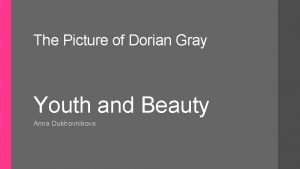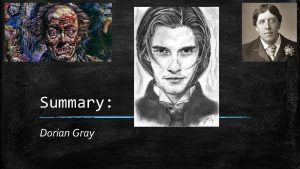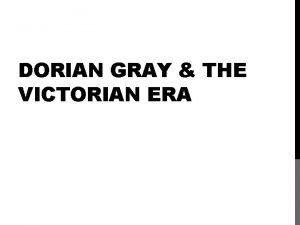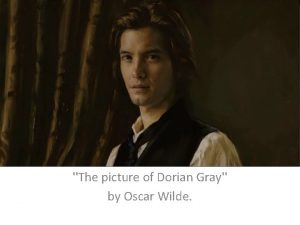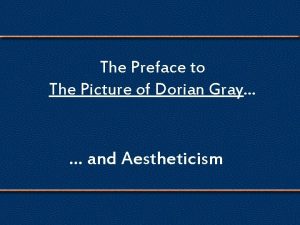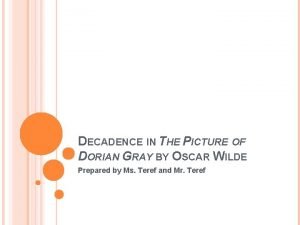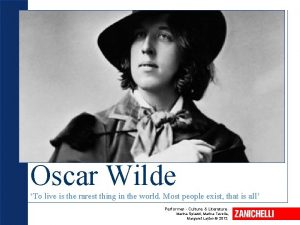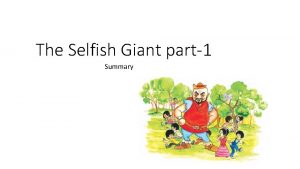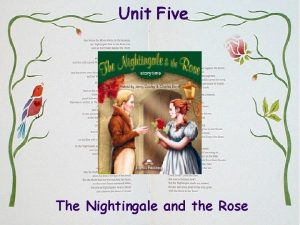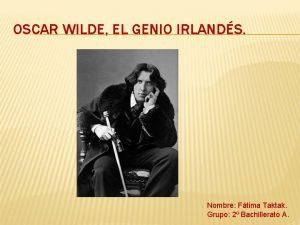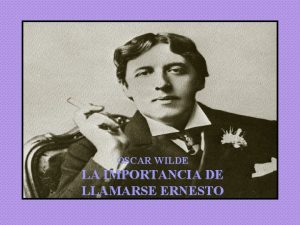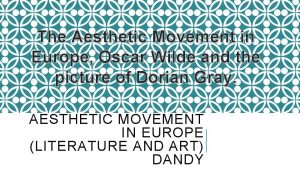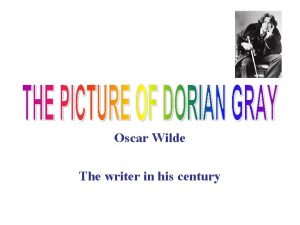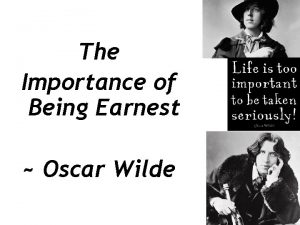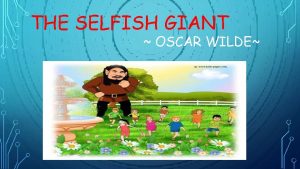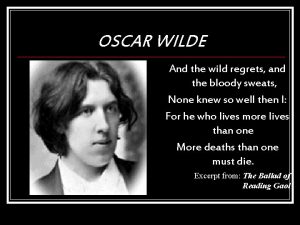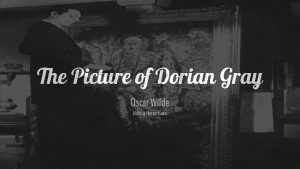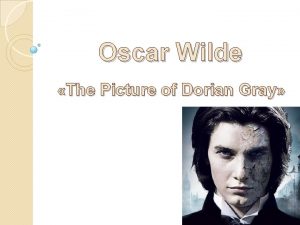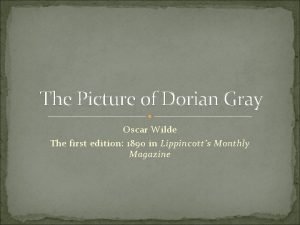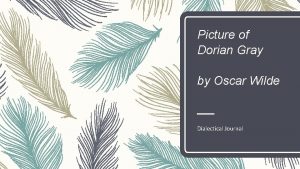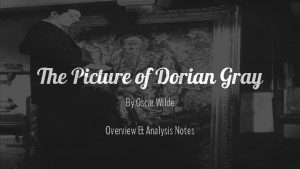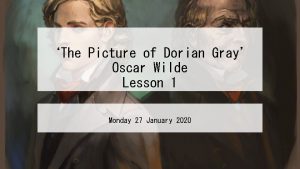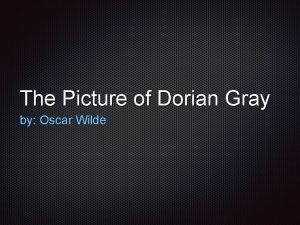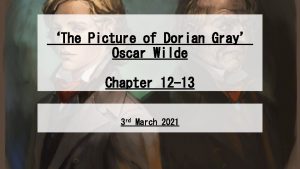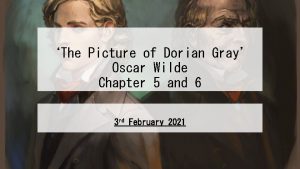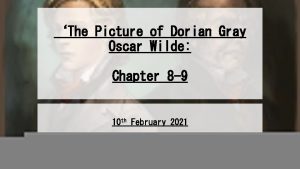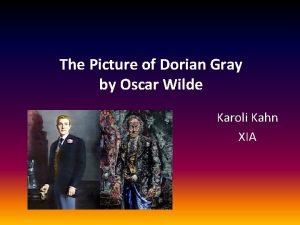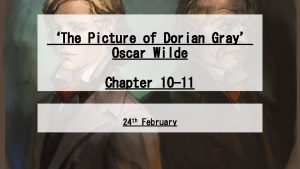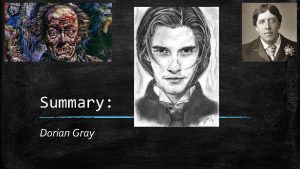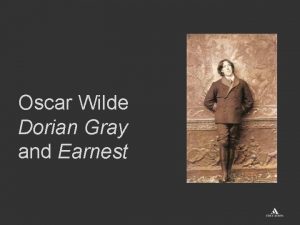The Picture of Dorian Gray Oscar Wilde Natalia



















- Slides: 19

The Picture of Dorian Gray Oscar Wilde Natalia Heckermann

Oscar Wilde (1854 -1900) Born in Dublin, Ireland October 16, 1854 Studied at Trinity College in Dublin and Magdalen College in Oxford Lived his adulthood in London Prominent figure in the Aesthetic movement Arrested for homosexuality Later lived in Paris where he became Roman Catholic before he died on November 30, 1900


(kinda) Cool Facts Walt Whitman was rumored to be one of Oscar Wilde’s love interests The Picture of Dorian Gray was considered so scandalous that there were several versions of the novel with parts of the book missing or partially censored Oscar Wilde carried a yellow book, like the untitled yellow book that encouraged Dorian Gray’s destruction

Other Famous Pieces of Work The Importance of Being Earnest Salome The Happy Prince and Other Tales The House of Pomegranates The Portrait of Mr. W. H.

Victorian Aestheticism Movement “During the mid-nineteenth century, the provocative and sensuous Aesthetic movement threatened to dismantle Britain's fussy, overbearing, and conservative Victorian traditions. More than a fine art movement, Aestheticism penetrated all areas of life - from music and literature to interior design and fashion. At its heart was the desire to create "art for art's sake" and to exalt taste, the pursuit of beauty, and self-expression over moral expectations and restrictive conformity. The freedom of creative expression and sensuality that Aestheticism promoted exhilarated its adherents, but it also made them the object of ridicule among conservative Victorians. Nonetheless, by rejecting art's traditionally didactic obligations and focusing on self-expression, the Aesthetic movement helped set the stage for global, twentieth-century modern art. ” (Souter, The Aesthetic Movement)

Central Characters Dorian Gray: The young, handsome gentleman who captivates everyone’s attention. He is the muse to all of Basil’s work and the victim of Lord Henry’s influence Lord Henry Wotton: A well-spoken and charming man (not as charming as Dorian) who strongly values aesthetic and hedonic ideals. He represents evil in the novel. Basil Hallward: The humble painter and friend of Lord Henry who represents goodness throughout the novel

Summary A handsome and captivating young man named Dorian Gray sells his soul for eternal youth and beauty once he sees a portrait of himself painted by his dear friend Basil. Throughout the novel, Dorian’s morals and values disintegrates with the influence of Lord Henry Wotton and his aesthetic/hedonic ideals, which ultimately is what leads to Dorian’s overall state of corruption.

Themes youth/ Dorian Gray obsesses over youth and beauty homosexuality(? )/ Basil loves Dorian, Lord Henry loves Dorian, Dorian loves Lord Henry…. each male character loves another male character in one way or another…. morality/ Lord Henry refutes morals thourgh the novel, encouraging Dorian to do the same good vs evil/ Basil and Lord Henry are the main influencers in Lord Henry’s life and they practically fight for Dorian’s attention/soul appearance vs reality/ Evil appears to be appealing, when it is actually deadly

Thesis In Oscar Wilde’s The Picture of Dorian Gray, the author explores the central theme of moral decay and the consequences of influence which is expressed through Dorian Gray’s fall and the factors that led up the his ultimate state of complete destruction including the many reasons why Dorian Gray became the ideal victim of irreversible evil. What made Dorian Gray susceptible to corruption?

The ideal breeding ground In The Picture of Dorian Gray, Dorian Gray lives amongst people in the upper class who start or already have abandoned moral values, such as Lord Henry Wotton, who becomes close friends with Gray. The increase of aesthetic and hedonic beliefs and behaviors puts morals on the back burner within the novel’s story. Victorian London entered the transition between high morals set by Queen Victoria to the “falter” of values “with the emergence of Aestheticism and Decadence” that is called the Decadent Movement. This movement focuses particularly on art and pleasure (Franssen, Surface and Symbol in The Picture of Dorian Gray).

The Curse that Comes with Compliments This extreme vanity makes Dorian Gray belive that he is completely indestructible. “. . a revelation. He had never felt it before. . . Then had come Lord Henry Wotton with his strange panegyric youth, his terrible warning of its brevity. That had stirred him at the time, and now, as he stood gazing at the shadow of his own loveliness, the full reality of the description flashed across him Yes, there would be a day when his face would be wrinkled and wizen, his eyes dim and colourless, the grace of his figure broken and deformed. The scarlet would pass away from his lips, and the gold steal from his hair. The life that was to make his soul would mar his body. He would become dreadful, hideous, and uncouth. “ (Wilde 28) Dorian Gray’s awakening to his fading youth and surreal charm serves as a catalyst for becoming subjected to the darkness of aesthetic and hedonic ideals, which also encourages the continuance of Gray’s self-absorbed behavior since “self-absorption, then, appears to be an inevitable consequence of aestheticism” (Duggan, The Conflict Between Aestheticism)

the Allure of Evil Dorian Gray is introduced to the aesthetic and hedonic principles that Lord Henry lives his life upon in such a captivating and alluring way that creates the illusion of underlying evil as being something that is good and attractive, or even nonexistent. “Lord Henry Wotton trumpets the aesthetic philosophy with an elegance and bravado that persuade Dorian to trust in the principles he espouses” (Pappas 37) “ I believe that if one man were to live out his life fully and completely, were to give form to every feeling, expression to every thought, reality to every dream - I believe that the world would gain such fresh impulse of joy…” (Wilde 20)

The Allure of Evil cont. Lord Henry presents to Dorian Gray a false friendship that builds a trust based on deceit that also encourages Dorian to adapt Lord Henry’s beliefs and lifestyle into the life of his own. The closeness that Dorian Gray feels to Lord Henry is uncanny, so much so that, “Dorian feels like Harry knows him more than he knows himself”(Magnusdottir, The Battle of Good and Evil in The Picture of Dorian Gray) “ You have explained me to myself, Harry” (Wilde 67)

Good vs Evil Lord Henry personifies evil “Moderation is a fatal thing. Enough is as bad as a meal. More than enough is as good as a feast” (Wilde 204) “A man can be happy with any woman, as long as he does not love her” (Wilde 203) - Shows hedonism - Parallel with Oscar Wilde’s life - “Oscar Wilde himself broaches the subject very poignantly when he looks at one of his socalled lovers, and he asks him, “In loving one of those boys, did you ever love anyone of them for themselves? ’ And he pauses and says, ‘No, I never did. ’ And Wilde says, ‘Neither did I. ’ “

Good vs Evil cont. . . In contrast to Lord Henry Wotton, Basil Hallward is presented in the novel as a true source of goodness “You have a wonderful influence. Let it be for good, not for evil. They say that you corrupt everyone with whom you become intimate, and that is quite sufficient for you” (Wilde 172)

When bad outweighs the good The narrator describes Dorian Gray as being “conscious how unjust, how cruel, he had been to Sibyl Vane” (Wilde 108). Dorian knows the path he is going, yet continues by choice “It often happens that the real tragedies of life occur in such an inartistic manner that they hurt us by their crude violence, their absolute incoherence, their absurd want of meaning, their entire lack of style. . . Sometimes, however, a tragedy that possesses artistic elements of beauty crosses our lives. . . Someone has killed herself for love of you. I wish that I had ever had such an experience. It would have made me in love with love for the rest of my life. ” (Wilde 114) “There is something quite beautiful about her death. I am glad i am living in a century when such wonders happen” (Wilde 116) “I don’t feel upset” (Wilde 118)

Sealing the deal The yellow book is like a bible to Dorian Gray, which he worships and lives his life upon “Dorian Gray could not free himself from the influence of this book. Or perhaps it would be more accurate to say that he never sought to free himself from it” (Wilde 144). The yellow book was given to Dorian by Lord Henry who uses this ‘gift’ of his as a way to ‘seal the deal’ in terms of Dorian wholeheartedly committing himself to Lord Henry’s twisted philosophies

Works cited Franssen, Paul. "Surface and Symbol in The Picture of Dorian Gray. " JSTOR [JSTOR]. N. p. , May 2010. Web. 20 Apr. 2017. Magnusdottir, Svanhvit Helga. "The Battle of Good and Evil in The Picture of Dorian Gray. "JSTOR [JSTOR]. N. p. , Sept. 2015. Web. 20 Apr. 2017 Pappas, J. J. "The Flower and the Beast: A Study of Oscar Wilde's Antithetical Attitudes Toward Nature and Man in The Picture of Dorian Gray. " English Literature in Transition, 1880 -1920, vol. 15 no. 1, 1972, pp. 37 -48. Project MUSE, muse. jhu. edu/article/369795. "Victorian Era Life in England. Information about Society & Daily Life. " Victorian-Era. org. N. p. , n. d. Web. 20 Apr. 20 Wilde, Oscar. The Picture of Dorian Gray. New York: Modern Library, 2004. Print. 17 Zacharias, Ravi. "A Conversation with Ravi Zacharias – Janet Parshall. " RZIM. N. p. , n. d. Web. 23 Oct. 2002.
 Youth and beauty in the picture of dorian gray
Youth and beauty in the picture of dorian gray The picture of dorian gray chapter 18
The picture of dorian gray chapter 18 The picture of dorian gray plot
The picture of dorian gray plot The picture of dorian gray victorian era
The picture of dorian gray victorian era Dorian gray discussion questions
Dorian gray discussion questions Dorian grey sibyl
Dorian grey sibyl Preface to the picture of dorian gray
Preface to the picture of dorian gray Fascist
Fascist The canterville ghost by oscar wilde
The canterville ghost by oscar wilde Oscar wilde zanichelli
Oscar wilde zanichelli Oscar wilde sebični div
Oscar wilde sebični div The selfish giant summary
The selfish giant summary Image of rose
Image of rose El genio irlandes
El genio irlandes Oscar wilde ernest
Oscar wilde ernest Dandy aesthetic movement
Dandy aesthetic movement Texte anglais bac
Texte anglais bac Irony in the importance of being earnest
Irony in the importance of being earnest The selfish giant oscar wilde analysis
The selfish giant oscar wilde analysis Oscar wilde regret
Oscar wilde regret
